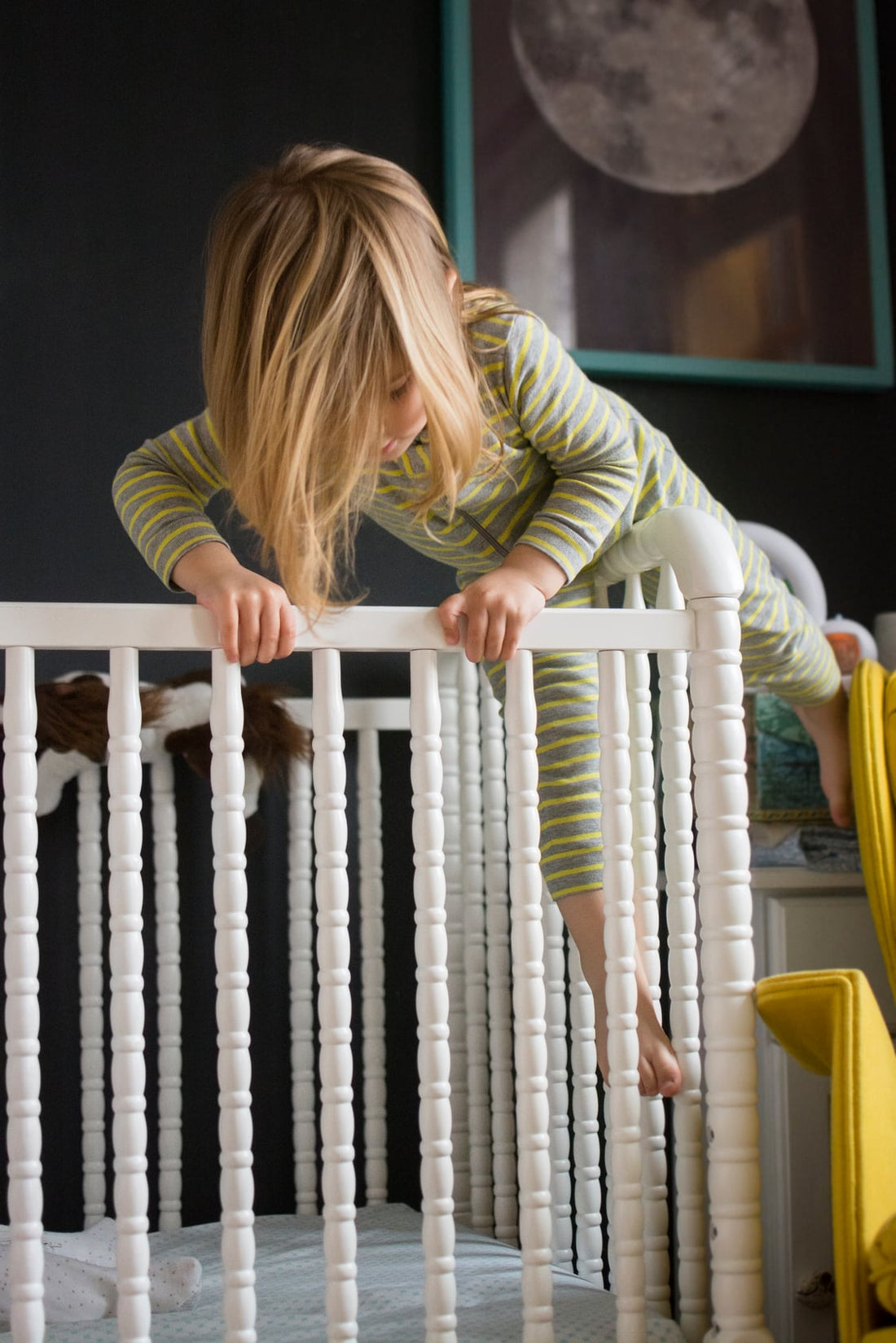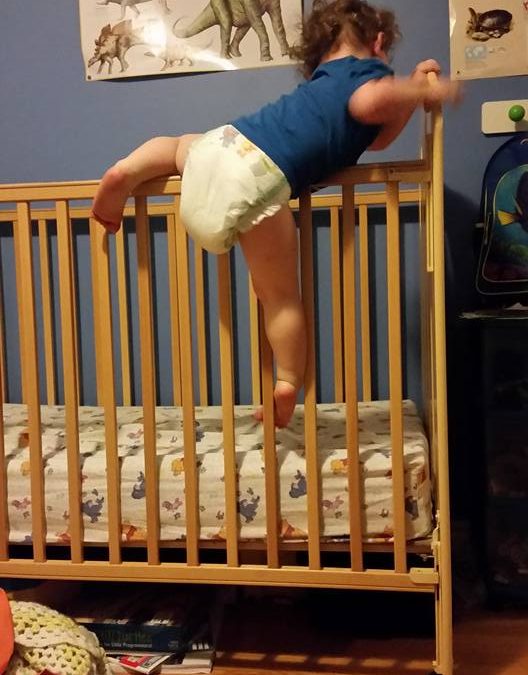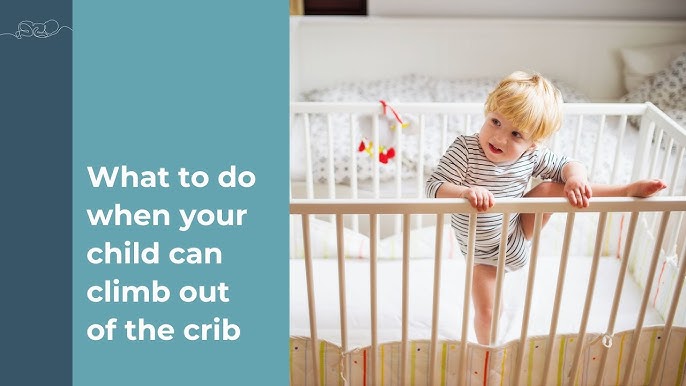To prevent your toddler from climbing out of the crib, consider lowering the mattress and removing any climbing aids. Transitioning to a toddler bed can also help ensure their safety.
Seeing your toddler climb out of their crib can be alarming. It’s a sign they are ready for more freedom and independence. Safety becomes a top priority as they explore their surroundings. Toddlers are naturally curious, and their climbing skills can pose risks.
You’ll want to create a safe sleep environment while encouraging their development. Understanding when to make changes can ease both your worries and their transition. This guide offers practical steps and tips to manage this exciting yet challenging stage in your child’s life. Keep your toddler safe and secure while promoting their growing independence.
Table of Contents

Credit: www.mothertogether.com
Early Signs Of A Climbing Toddler
Watching your toddler grow is exciting. Yet, it can also be challenging. One major concern is when they start climbing out of their crib. Recognizing early signs can help keep your child safe. Here are some signs that your little one may be ready to climb.
Recognizing The Urge To Climb
Toddlers are naturally curious. They love to explore their surroundings. When they start to pull themselves up, it’s a clear sign. They may want to climb out of their crib.
Look for these signs:
- Pulling up: Your toddler pulls themselves up on furniture.
- Standing: They can stand without support.
- Reaching: They reach for toys placed out of their reach.
- Climbing: They try to climb over objects in their path.
Behavioral Cues To Watch For
Behavior can tell a lot about your toddler’s climbing intentions. Watch for these cues:
| Behavior | Description |
|---|---|
| Increased energy: | They seem more energetic and restless. |
| Fidgeting: | They move around a lot while in the crib. |
| Testing limits: | They try to climb out during nap time. |
| Curiosity: | They show interest in what’s outside the crib. |
Recognizing these signs helps you act early. Taking action can prevent falls and injuries. Keep an eye on your toddler’s behavior. Stay proactive in ensuring their safety.
Safety First: Assessing The Risks
When your toddler climbs out of the crib, safety becomes a priority. It’s essential to understand potential dangers and prepare the environment. Assessing risks helps prevent injuries and keeps your little one safe.
Potential Injuries From Climbing
Toddlers are curious and adventurous. Climbing out of the crib can lead to serious injuries. Here are some common risks:
- Falls: Falling from height can cause fractures.
- Head injuries: A fall may lead to concussions.
- Bruises and cuts: Sharp edges can cause skin injuries.
- Strangulation: Loose bedding or toys may pose a risk.
Always monitor your child closely. Understanding these potential injuries helps in taking precautions.
Securing The Bedroom Environment
Creating a safe bedroom is vital. Follow these steps to secure the environment:
- Remove furniture near the crib.
- Check for sharp objects on the floor.
- Install safety gates at doorways.
- Use a crib mattress on the lowest setting.
- Keep windows locked and out of reach.
These steps help minimize risks. A secure bedroom ensures your toddler can explore safely. Regularly check the environment for new hazards.
When To Transition To A Toddler Bed
Deciding when to move your toddler from a crib to a bed can be tricky. Many factors influence this transition. Understanding the right time can help your child feel secure and comfortable.
Age-appropriate Bed Changes
Most toddlers transition to a bed between 18 months and 3 years. Here are some general age guidelines:
| Age | Recommended Action |
|---|---|
| Under 18 months | Keep in crib for safety |
| 18 months – 2 years | Consider bed if climbing out |
| 2 – 3 years | Transition to toddler bed |
| Over 3 years | Use twin bed if needed |
Signs Your Child Is Ready For A Bed
Watch for these signs that your toddler may be ready for a bed:
- Climbing out of the crib: This is a strong indicator.
- Showing interest: If your child talks about beds or points to them.
- Potty training: If your child is using the potty regularly.
- Sleeping through the night: Consistent sleep patterns are a good sign.
- Size: If your child is getting too tall for the crib.
Recognizing these signs helps ensure a smooth transition. A toddler bed can provide more freedom and comfort. Make the change when you feel your child is ready.
Crib Modifications To Prevent Climbing
As toddlers grow, they become adventurous. Climbing out of the crib is common. Making simple modifications can keep your little one safe. Here are some effective ways to prevent climbing.
Adjusting Crib Settings
Start by checking the crib settings. Adjust the mattress height for safety. Follow these tips:
- Lower the mattress to the lowest setting.
- Ensure the crib sides are secure and locked.
- Remove bumpers and soft bedding to prevent climbing.
These adjustments help reduce the chance of climbing. A lower mattress makes it harder to escape.
Aftermarket Products That Help
Consider using aftermarket products. These can enhance crib safety. Here are some options:
| Product | Purpose |
|---|---|
| Crib tent | Prevents climbing and keeps your child safe inside. |
| Crib rails | Increases height and reduces climbing chances. |
| Anti-climb crib cover | Covers the top of the crib and stops escapes. |
These products can make a big difference. Choose one that fits your crib style.
Training Your Toddler To Stay Put
When toddlers climb out of their cribs, it can be alarming. Parents must teach their little ones to stay safe in their beds. Use positive reinforcement and establish a bedtime routine. Both strategies help toddlers feel secure and calm.
Positive Reinforcement Techniques
Positive reinforcement encourages good behavior. Reward your toddler for staying in the crib. Here are some effective techniques:
- Praise: Verbally commend your toddler for staying put.
- Stickers: Use a sticker chart to track progress.
- Small treats: Offer a favorite snack for staying in bed.
- Extra playtime: Allow extra playtime as a reward.
Make rewards immediate. This helps your toddler connect staying in bed with positive outcomes. Consistency is key. Repeat the process every night.
Establishing A Bedtime Routine
A strong bedtime routine creates a calming environment. Follow these steps for an effective routine:
- Set a regular bedtime. Aim for the same time each night.
- Start with a calming activity. Consider reading a book or singing a lullaby.
- Dim the lights. This signals bedtime is near.
- Use a comfort item. A favorite stuffed animal can provide security.
- Stay consistent. Follow the same steps every night.
This routine helps toddlers understand what to expect. They feel more secure and are less likely to climb out of the crib.

Credit: momsoncall.com
The Role Of Sleepwear
Sleepwear plays a crucial role in your toddler’s safety. The right pajamas can keep them comfortable and less likely to climb out of their crib. Choosing suitable sleepwear can help prevent nighttime escapades. Let’s explore how to select the best pajamas for your little one.
Choosing The Right Pajamas
Selecting the right pajamas is essential for safety and comfort. Consider these factors:
- Fit: Pajamas should fit snugly but not too tight.
- Material: Choose breathable fabrics like cotton.
- Length: Long sleeves and pants can prevent climbing.
- Closure: Avoid pajamas with loose buttons or zippers.
Opt for pajamas that your toddler cannot easily remove. This choice can reduce the chance of nighttime climbing.
How Sleepwear Can Deter Climbing
Sleepwear can discourage toddlers from climbing out of their cribs. Here’s how:
- Anti-slip bottoms: Look for pajamas with grippy soles.
- Footed pajamas: These keep little feet warm and secure.
- Elastic cuffs: Cuffs can prevent pants from riding up.
Consider these tips:
- Choose pajamas with a snug fit.
- Look for styles that cover the ankles.
- Use sleep sacks for extra security.
By focusing on the right sleepwear, you can help keep your toddler safe in their crib.
Childproofing Beyond The Crib
When toddlers climb out of their cribs, safety becomes a priority. Childproofing your home is essential. Your little explorer needs a safe space to roam. Here are key areas to focus on beyond the crib.
Securing Furniture And Windows
Furniture can pose hidden dangers. Toddlers love to climb and explore. Secure heavy furniture to the wall. This prevents tipping accidents.
- Bookcases: Anchor them to the wall.
- Dressers: Use anti-tip straps.
- Tables: Avoid sharp corners; use corner guards.
Windows are another concern. Open windows can be risky for adventurous toddlers. Always install window locks or guards.
- Keep windows closed or locked.
- Use window screens for added protection.
Installing Safety Gates
Safety gates are vital for keeping toddlers safe. Install them in key areas of your home.
| Location | Recommended Gate Type |
|---|---|
| Top of stairs | Hardware-mounted gates |
| Bottom of stairs | Pressure-mounted gates |
| Doorways | Pressure-mounted gates |
Choose gates that are at least 30 inches high. Ensure they meet safety standards. Teach your toddler not to climb over them.
Effective Communication Strategies
Helping your toddler understand the dangers of climbing out of the crib is essential. Using effective communication strategies can make this process easier. Here are some tips to ensure your child grasps the importance of safety in simple terms.
Explaining Safety To Your Toddler
Talk to your toddler about safety in a clear and friendly way. Use simple words they can easily understand. Here are some techniques to help convey your message:
- Use visuals: Show pictures of safe and unsafe actions.
- Role-play: Act out scenarios to demonstrate safe behavior.
- Storytime: Read books that focus on safety themes.
Keep explanations short and to the point. Repeat important messages often. Here are some key phrases to use:
- “Stay in your crib for safety.”
- “Climbing can cause you to fall.”
- “We want you to be safe and sound.”
Using Child-friendly Language
Choose words your toddler can relate to. Avoid complex terms. Use familiar phrases and fun expressions. Here are some examples:
| Complex Term | Child-Friendly Alternative |
|---|---|
| Danger | Uh-oh! |
| Fall | Oops! |
| Climbing | Up, up! |
Reinforce positive behavior. Praise your toddler for staying in the crib. Celebrate small successes with cheers or stickers. This encourages them to follow safety guidelines.
Dealing With Night-time Escapes
Night-time escapes can be stressful for parents. Toddlers climbing out of their cribs disrupt sleep. Understanding how to handle this situation helps keep everyone safe and calm.
Immediate Steps To Take
Act quickly to ensure your toddler’s safety. Here are some essential steps:
- Check for injuries: Ensure your child is unharmed.
- Return them to bed: Gently place them back in the crib.
- Stay calm: Your reaction influences their behavior.
- Use a nightlight: A soft light can help ease fears.
- Monitor the room: Remove any objects that aid climbing.
Preventing Recurrence
Preventing future escapes is key to peaceful nights. Implement these strategies:
- Lower the crib mattress: Adjust it to the lowest setting.
- Install crib tent: Consider a safe crib tent for extra security.
- Transition to a toddler bed: Move to a bed when necessary.
- Create a bedtime routine: Establish calming pre-sleep activities.
- Use a sleep sack: A wearable blanket can limit movement.
Evaluate your toddler’s readiness for these changes. Each child is different. Maintain consistent sleep habits to foster a sense of security.

Credit: kindersleep.com
Monitoring Techniques For Peace Of Mind
When your toddler climbs out of the crib, safety becomes a top concern. Monitoring techniques can help you keep an eye on your little one. These methods ensure you know what your child is doing at all times.
Using Baby Monitors Effectively
Baby monitors are essential tools for parents. They allow you to watch or listen to your child remotely. Here are some tips to use them effectively:
- Choose a reliable model: Look for features like video and sound.
- Position wisely: Place the monitor to capture the entire crib.
- Set alerts: Use alerts for noise or movement detection.
- Test regularly: Ensure it works properly every few days.
Pros And Cons Of Surveillance
Surveillance can provide peace of mind. Here are some pros and cons to consider:
| Pros | Cons |
|---|---|
| Enhances safety. | Can invade privacy. |
| Gives real-time updates. | May cause anxiety for some parents. |
| Allows for quick response. | Dependent on technology. |
Using baby monitors can help ease your worries. Weigh the pros and cons to find what works best for your family.
Involving Your Toddler In The Transition
Involving your toddler in the transition from crib to bed can make the process smoother and more enjoyable. Engaging them fosters a sense of ownership. This helps reduce anxiety and resistance. Here are two key ways to make this transition successful.
Choosing A Bed With Your Child
Let your toddler help choose their new bed. This gives them a sense of control. Here are some tips to make this process engaging:
- Visit a store together to explore options.
- Discuss different bed styles and colors.
- Consider a toddler bed or a low twin bed.
Ask your child questions about their preferences:
- What color do you like?
- Do you prefer a character theme?
- Which style looks the coziest?
Involving them in this decision builds excitement. It also helps them feel part of the change.
Making The New Bed Exciting
Transform the new bed into a fun space. Use their favorite themes and colors. Here are some ideas:
- Add colorful beddings featuring characters.
- Decorate the space with fun wall decals.
- Include soft toys for comfort.
Organize a special “big kid” celebration:
- Invite family for a small gathering.
- Take photos of your child in their new bed.
- Share the excitement on social media.
These steps create a positive association with the new bed. Your toddler will look forward to sleeping in their new space.
Professional Advice And Resources
Dealing with a toddler who climbs out of their crib can be challenging. Seeking professional advice and utilizing available resources can help ensure your child’s safety. You can find guidance from pediatricians and support from online communities.
When To Consult A Pediatrician
Consulting a pediatrician is vital in certain situations:
- Your child shows signs of distress or anxiety.
- Climbing out leads to injuries or close calls.
- You feel overwhelmed and need guidance.
- Your child has special needs or medical conditions.
Pediatricians can provide tailored advice. They may suggest strategies to help your toddler feel secure in their crib.
Online And Community Support
Online forums and community groups offer valuable support for parents. Here are some options:
- Parenting forums: Join discussions with other parents.
- Social media groups: Share experiences and tips.
- Local parenting classes: Learn from professionals.
Connecting with others can provide reassurance. Hearing similar stories helps you feel less alone in this journey.
Preparing For The Next Milestones
As your toddler climbs out of the crib, it signals a big change. They are ready for new challenges and adventures. This stage requires careful planning and adjustments.
Anticipating Future Developmental Leaps
Children grow and learn at their own pace. Watch for signs of readiness. Here are some common developmental milestones:
| Age | Milestone |
|---|---|
| 18 Months | Walking and climbing independently |
| 2 Years | Talking in short sentences |
| 3 Years | Potty training begins |
Be prepared for changes in sleep habits. Toddlers may resist bedtime. They might want to explore their surroundings at night.
Adapting To Your Growing Child
Adjust your home to fit your child’s needs. Here are some ways to create a safer environment:
- Switch to a toddler bed.
- Remove sharp objects from reach.
- Use safety gates for stairs.
Encourage independence and exploration. Offer choices like clothing or snacks. Let your toddler decide what to play with.
Establish consistent routines. Routines help children feel secure. Predictable schedules make transitions smoother.
Communicate clearly with your child. Explain what is expected. Use simple language they can understand.
Frequently Asked Questions
What Causes Toddlers To Climb Out Of The Crib?
Toddlers climb out of cribs due to curiosity, restlessness, or the desire for independence as they grow.
How Can I Prevent Crib Climbing?
Lower the crib mattress, use a sleep sack, or install crib tenting to discourage climbing out.
What Age Do Toddlers Typically Escape Cribs?
Most toddlers start climbing out between 18 months and 3 years old, as their mobility increases.
Should I Switch To A Toddler Bed?
Consider transitioning to a toddler bed when your child consistently climbs out, ensuring safety and comfort.
Conclusion
Managing a toddler who climbs out of the crib can be challenging. Safety should always be your top priority. Consider transitioning to a toddler bed for more freedom. Establish a consistent bedtime routine to promote better sleep. With patience and the right strategies, you can ensure a safe and restful environment for your little one.







